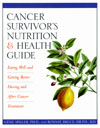Eating Well and Getting Better During and After Cancer Treatment
Author: Gene Spiller, PhD and Bonnie Bruce, DrPH, RD |
Dr. Spiller and Dr. Bruce believe that a person's diet affects their health, and hence their ability to fight and prevent disease. They are nutritionists who believe that food can be an effective weapon in the fight against cancer. They have done both scientific research, and interviewed cancer patients, to put together this book of recipes that they feel can help improve a cancer patient's treatment outcome.
The book is broken down into two parts: the first half contains "Vital Information," the second half has recipes. The first half explains their philosophy, the ideas that are behind the recipes. These ideas can be summarized by two thoughts: first, a cancer patient's diet should be based on plant foods, with a minimal amount of animal products, and second, these plant foods should be as unrefined as possible to obtain a maximum amount of nutrients from them. They are very helpful, providing ideas for how to remain nourished both during treatment and thereafter, and also specifically for fighting certain side effects (eg. nausea, constipation, etc.).
The second half contains 100 recipes. Each recipe is designed to be nourishing, appealing to patients with nausea and sensitive throats, and yet taste good. The recipes are categorized as Supereasy (easy to swallow and digest), Easy (need to be able to chew and swallow, but pretty easy to digest), or Hearty (need an ability to chew, swallow and digest. Probably best for after treatment). Some examples are:
- Super easy Fruited Yogurt Smoothie
- Broccoli Bisque
- Easy Hi-Protein Egg Patties
- Miso Soup with Sticky Rice
- Hearty Mild Curried Spinach and Lentils
- Ginger Savoy
The recipes are simple, requiring few ingredients. Nutritional information is provided for each recipe as well.
This is a very well written book; almost every page is summarized briefly in the margins, making it very easy to read. It is nice that they provide the reader with the ideas behind their recipes, and one could probably use these ideas to design other recipes. The authors even provide a brief example of a cancer survivor who describes how he used these recipes during and after his treatment. They point out to the reader that one must "?remember that this book is not intended as a substitute for medical advice."


